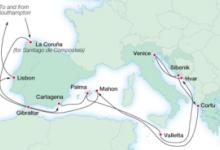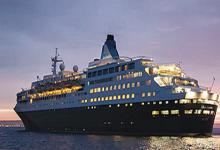Recently Viewed Cruises
- Saga Sapphire, Wonders of the Mediterranean ex Southampton ReturnAdd to favourites
- Oceana, Western Mediterranean E307/E315/E317/E321 ex Southampton ReturnAdd to favourites
- Crown, Passage to Europe ex Galveston to SouthamptonAdd to favourites
- Crown, Canary Is & Western Europe ex Galveston to SouthamptonAdd to favourites
- Oceana, Short Break ex Southampton ReturnAdd to favourites
- Oceanic Discoverer
- Ab Fab Oosterdam
- Catch up on Cruising: Latest cruise news in bite size
- Catch up on Cruising: Latest cruise news in bite size
- Catch up on Cruising: Latest cruise news in bite size
- Frequently Asked Questions
-
Saga Sapphire, Wonders of the Mediterranean ex Southampton Return
Nights 22 Ship Saga Sapphire Star Rating 
Departs Southampton, England Sailing 2013: 14 Apr Ports of Call Southampton, La Coruna, Cartagena, Palma, Valletta, Hvar, Venice, Sibenik More Corfu, Mahon, Gibraltar, Lisbon Please enquire about this cruise for pricing.
22 Night Cruise sailing from Southampton roundtrip aboard Saga Sapphire.
Head for the spring sunshine on this voyage through thousands of years of civilisation. As you journey around the very heart of the Mediterranean, you'll visit cultural cities such as Valletta and Lisbon as well as ancient towns rich in history.
Saga Sapphire will also sail into the Adriatic Sea to explore Croatia and the unforgettable city of Venice on this classic cruise.
Highlights of this cruise:
Cartagena
A Mediterranean city and naval station located in the Region of Murcia, southeastern Spain, Cartagena has been the capital of the Spanish Navy's Maritime Department of the Mediterranean since the arrival of the Spanish Bourbons in the eighteenth century.
As far back as the sixteenth century it was one of the most important naval ports in Spain, together with Ferrol in the North.
It is a walled town and has a fine harbour defended by forts. In the time of Philip II of Spain, it was a major naval seaport of Spain and is still the main military haven of the country.
Palma, Majorca
Set on the south coast of Majorca, Palma is the capital of the Balearic Islands. A vibrant city deservedly fitting its status, it has nonetheless managed to retain much of its traditional charm and culture.
Past settlers have left their mark on Palma and this is evident as you stroll around the city, particularly in sights such as the Arab baths and the Almudaina Palace. Indeed, the Balearic capital has a wealth of attractions, including the Bellver Castle which has dominated the skyline since the 14th century. But this is outclassed by the cathedral, a Gothic masterpiece which in its present form took almost 400 years to complete.
Undoubtedly one of Palma's best features is the main promenade of Passeig d'es Born that is lined with plane trees and adorned with flowers. If you want to seek a little solace from city life, the beautiful Parc de Mar is built on several levels and its focal points are a man-made lake and a colourful mural by Joan Miro, one of the park's designers.
It is not just history that gives Palma its charm. It is also a cultural centre and plays host to numerous concerts, while its variety of restaurants and multitude of bars mean there is always somewhere to relax and savour the special atmosphere of the city.
Hvar
The largest of the Croatian islands, Hvar is one of the treasures of the Adriatic.
Known for its art, excellent beaches and fields of scented lavender, it has been ruled in turn by the Romans, Byzantines, Venetians and the Austro-Hungarian Empire. The island has caves which show signs of prehistoric habitation, whilst weather records consistently show Hvar as one of the sunniest places in Europe.
The first public library ever built in the Dalmatian Islands was founded here in 1868 and the medieval town of Hvar is surrounded by 13th-century fortifications. There are also fine Gothic townhouses to be found in its narrow streets.
Venice
Located on the north-western side of the Adriatic, you moor in the enchanting city of Venice, famed for its romantic gondolas, Renaissance palaces and baroque churches. The city itself lies on an archipelago in a shallow, crescent-shaped lagoon and features some 160 canals crossed by over 450 bridges.
Immerse yourself in the lively, bustling atmosphere and go in search of its outstanding churches including the elaborate Basilica di San Marco, the beautiful Campanile di San Marco which offers spectacular panoramic views across the city, and San Giovanni in Bragora where the composer Vivaldi was once the organist.
There is also a wonderful choice of museums and galleries, from Accademia, Venice's greatest art gallery, to the Naval Museum which displays Italy's best collection of maritime artifacts and memorabilia. Famous landmarks of this great city are innumerable, but perhaps the best known is St Mark's Square and elegant Rialto Bridge.
Corfu
Corfu is the most popular of the Ionian islands. A verdant oasis, it has four million olive trees, orange and lemon groves, striking architecture, wonderful coastal scenery and secluded beaches.
Reputedly the island where the Argonauts found refuge from the avenging Cholchic fleet after they had acquired the Golden Fleece, it is also said to be the Homeric island of Scheria where the Phaeacians, seafaring people, hospitably received Odysseus on his return from Troy. This fertile island is 36 miles long, 15 miles at its widest part, and covered in pine, cypress and fields of flowers.
Corfu Town, the capital, is one of the most beautiful and elegant in Greece, particularly the architecture in the medieval Old Town and the Jewish quarter, which reflects a flavour of Venice and Naples.
There are many sights of interest on the island including the beautiful Achilleion Palace and gardens that have an idyllic setting overlooking the sea; the 13th-century Byzantine Monastery of Virgin Mary; picturesque villages and secluded coves with beautiful sandy beaches lapped by the Ionian Sea.
The novelist and poet Lawrence Durrell lived on Corfu with his younger brother Gerald, the author and zoologist who acquired a menagerie of assorted wild animals.
Gibraltar
Tagged on to the end of Iberia, the intriguing British outpost of Gibraltar is dominated by a sandy peninsula and the stunning 1,400-feet-high limestone Rock. Although small, Gibraltar has always been seen as having great strategic importance on account of its advantageous position where the Atlantic meets the Mediterranean, just 12 miles from the coast of Africa.
Ever popular with British holidaymakers, Gibraltar is very much a home from home, boasting excellent duty-free shopping in many familiar British high street shops.
Lisbon
Set on seven hills on the banks of the River Tagus, Lisbon has been the inspiring capital of Portugal since the 13th century when the Moors were finally vanquished.
It is a city strewn with majestic architecture, old wooden trams, historic Moorish features and more than twenty centuries of history.
Following disastrous earthquakes in the 18th century, Lisbon was rebuilt by the Marques de Pombal who created an elegant city with wide boulevards and a great riverfront and square, Praça do Comercio.







